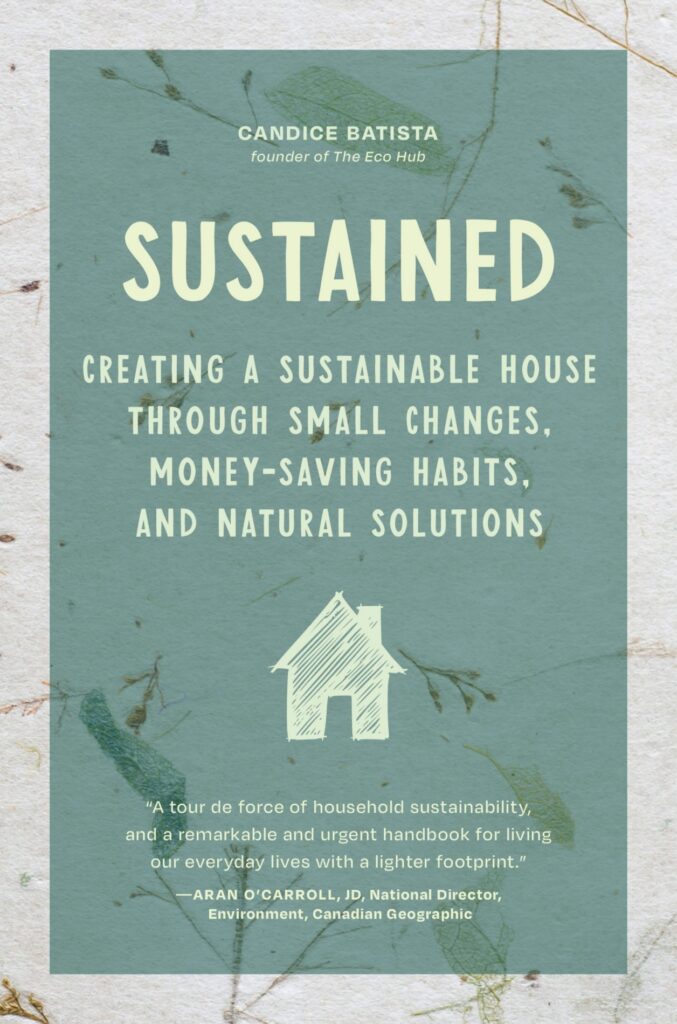Looking for ways to live a more sustainable life? Candice Batista, award-winning environmental journalist and first-time Canadian author’s much anticipated eco-living handbook, Sustained: Creating a Sustainable House Through Small Changes, Money-Saving Habits, and Natural Solutions, has hit bookshelves across the country! Packed with money-saving sustainability tips, Candice’s new book shares small swaps and simple steps to take toward a more sustainable lifestyle. From green cleaning alternatives to ethical fashion recommendations, kitchen composting tips, waste management advice, fresh recipe ideas and more, Sustained is a comprehensive resource for those seeking a greener lifestyle without compromising their time, energy or budget. It’s available to purchase anywhere books are sold online, including Amazon and Indigo. The book is also available upon request through local bookstores. We chatted with Candice to learn more. —Noa Nichol


Hi Candice! Please tell us a bit about yourself to start.
Today, I’m the leading Sustainability Expert for Citytv’s Breakfast Television and Cityline as well as an author with the release of my new book Sustained: Creating a Sustainable House Through Small Changes, Money-Saving Habits, and Natural Solutions.
My commitment to the environment began three decades ago when I embarked on my career as an Environmental Journalist with The Weather Network. That role introduced me to numerous inspiring figures in the sustainability sector, many of whom weren’t receiving the attention they deserved in mainstream outlets. Motivated by this, I took a leap of faith, leaving my position to pioneer Canada’s first eco-centric TV program, ‘A Greener Toronto.’ That was nearly 18 years ago. Since then, I’ve been instrumental in crafting three additional eco-themed shows and a comprehensive 13-episode documentary series addressing climate change. To date, I’ve been involved in producing over 5,000 segments centered around sustainable living for various television and digital platforms.
Congrats on the release of your new book, Sustained: Creating a Sustainable House Through Small Changes, Money-Saving Habits, and Natural Solutions! What’s it about, and what was the impetus for writing it?
Thank you! My new book is an eco-living handbook, packed with practical insights that offers a step-by-step approach to turn every room in readers’ homes into a hub of sustainability, emphasizing small changes with big impacts. From green cleaning alternatives to ethical fashion recommendations, kitchen composting tips, waste management advice, fresh recipe ideas and more! It is a comprehensive resource for those seeking a greener lifestyle without compromising their time, energy, or budget.
Sustained reflects my passion for journalism and commitment to the environment. It was a joy to share my approach to sustainability and mindful living through writing this book.
Sustained is also about impact. I guide you through key areas of your home explaining the impact and then providing solutions. It’s very hard to navigate the world of sustainable living and in the book I make it easy for people to make small shifts in their habits. You can’t do it all at once, you need to start in one area and build habits from there. The kitchen is usually the best place to start.
Sustainable living is top of mind for many Canadians these days; what makes the tips/advice in your book different/unique, and practical?
Sustained shares tips to make sustainable living accessible to everyone. The book shares small changes people can make at home to reduce their environmental impact and save money.
I think what makes Sustained different is that it isn’t just tips but a shift in mindset. I encourage readers to rethink their relationship to consumption and to find new and creative ways to repurpose their belongings to give it a new life, avoiding trash in the landfill. With these small changes we can make a huge difference to our planet while saving money at the same time – it’s a win-win!
I’ve been helping people to love more mindfully for 30 years now. Many of the tips and advice in the book is based on that experience. Sustained offer a framework, or criteria that people can follow when making more mindful decisions.
In my quest to live more sustainably and ethically, I’ve developed a set of criteria that guide my choices, from the clothes I wear to the products I use. It’s about more than just the end product; it’s about understanding the journey each item has taken and the impact it has on our planet and its inhabitants.
Sustainable Materials and Ethical Sourcing: My first checkpoint is always the materials. Whether it’s the comforting feel of organic cotton or the innovative use of recycled plastics, I’m constantly seeking out products that minimize harm to our environment. But it’s not just about the material; it’s about the story behind it. I look for transparency in how these materials are sourced, preferring those that promote water conservation, reduce chemical use, and support ethical labor practices.
Ethical Manufacturing and Human Stories: The hashtag #whomademyclothes resonates deeply with me, extending beyond clothing to every product in my life. The tragic Rana Plaza collapse was a wake-up call, reminding us of the real human cost behind our consumer goods. I strive to support brands that not only provide transparency about their manufacturing processes but also actively work to improve the lives of their workers, ensuring fair wages, safe working conditions, and a dignified existence.
Corporate Social Responsibility: In today’s climate, a brand’s commitment to reducing its carbon footprint is more important than ever. I look for companies that go beyond mere promises, demonstrating real, measurable progress in reducing their environmental impact. This includes not just carbon emissions but also water usage, energy efficiency, waste reduction, and sustainable packaging. True sustainability means considering the entire lifecycle of a product, from creation to disposal, and striving to leave the smallest possible footprint.
What are the main “life” areas in which we can make impactful sustainable changes?
The home is a great place to start in making sustainable changes. Households are among the biggest contributors to global greenhouse gas emissions worldwide! Sustained focuses on small changes and habits at home impact the planet and offers a practical suite of never-before-seen tools and solutions to initiate the shift towards a greener lifestyle.
There are so many places in the home where sustainable swaps can make a huge difference for our planet’s future, from cleaning products, furniture, composting, fashion, to laundry and more!
The kitchen represents a pivotal starting point for adopting a more sustainable lifestyle, largely due to its central role in daily routines and its significant environmental impact. One of the most pressing issues addressed in the kitchen is food waste, which has far-reaching consequences on both the environment and global food security.
1. High Impact Area: The kitchen is where most household waste originates, especially food waste. It’s a space where small changes can lead to significant reductions in waste, energy usage, and water consumption. By focusing on sustainability in the kitchen, individuals can directly influence their environmental footprint.
2. Reducing Food Waste: A substantial portion of the food produced globally is wasted. This not only squanders the resources and energy used to produce, transport, and store this food but also contributes to greenhouse gas emissions when food waste decomposes in landfills. By managing food more efficiently at home, such as planning meals, storing food properly, and getting creative with leftovers, households can significantly reduce their contribution to food waste.
3. Composting: The kitchen is an ideal place to start composting organic waste. Composting turns food scraps and other organic materials into valuable compost, which can enrich soil and reduce the need for chemical fertilizers. This practice not only reduces the amount of waste sent to landfills but also helps sequester carbon in the soil, mitigating climate change.
4. Energy Efficiency: Kitchens are energy-intensive, with appliances like refrigerators, ovens, and dishwashers consuming significant amounts of electricity. By choosing energy-efficient appliances, using them wisely, and maintaining them properly, households can reduce energy consumption and lower their carbon footprint.
5. Water Conservation: Kitchens also present opportunities for water conservation. Simple acts like fixing leaks, using water-efficient fixtures, and adopting water-saving practices (like soaking pots and pans instead of running water to clean them) can substantially reduce water usage.
6. Conscious Consumerism: The kitchen is a hub for making conscious purchasing decisions that can support more sustainable food systems. This includes buying locally produced food, choosing seasonal produce, supporting organic farming, and reducing meat consumption. These choices can lower the environmental impact associated with food production and transport.
7. Packaging Waste: Reducing reliance on single-use plastics and disposable packaging in the kitchen can significantly cut down household waste. Opting for bulk purchases, using reusable containers, and embracing a zero-waste approach to shopping and food storage are effective strategies.
By addressing these aspects of kitchen use and food management, individuals can make a considerable impact on their environmental footprint. The kitchen, with its daily use and direct link to food and waste, offers a practical and impactful arena for implementing sustainable practices and contributing to a more sustainable future.
When it comes to maintaining new behaviors, do you have any advice?
Don’t be so hard on yourself! A sustainable lifestyle doesn’t just happen overnight. Remember, Rome was not built in a day. Change takes time! It’s a process.
In my book I reference Ralph Waldo Emerson’s famous quote, “Life is a journey, not a destination,” which truly encapsulates the mindset necessary for pursuing a sustained lifestyle in a world that often promotes the opposite. It’s not about being perfect. But it is about taking action and owning up to the realities of the waste we are creating and what we can do about it.
Small changes add up, especially over time. It’s all about a commitment to consistency.
If you could give three-to-five starting points for minimal-effort, budget-friendly sustainable living, what would they be?
I would say my number one tip for people just starting out would be to start rethinking your purchases. Rethinking in sustainable living and waste reduction encourages you to reevaluate your consumption habits, lifestyle choices, and overall mindset toward resources and waste. It involves questioning the status quo, challenging existing patterns, and considering the environmental impacts of our actions before making decisions.
Beginning to ask questions like, “do we genuinely feel nourished by an endless stream of new belongings, or are we filling voids with temporary fixes?” The answer may be less about acquiring and more about understanding what sustains us. This is how we reduce our overall consumption to help the planet.
In my book I share an ethical criteria which works in three parts: What Is It Made From, Sustainable Sourcing/Ethical Manufacturing and Corporate Social Responsibility. These questions are a great place to start.
Where can we find your book?
You can find Sustained anywhere books are sold online, including Amazon and Indigo. The book is also available upon request through local bookstores.

Be the first to comment